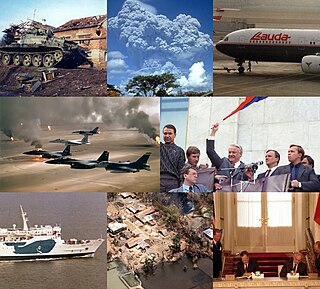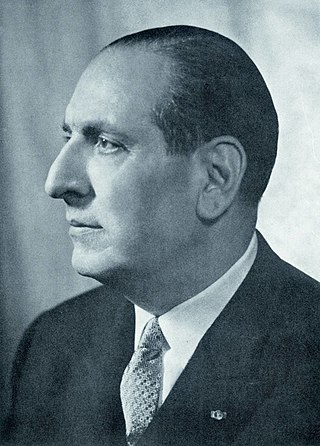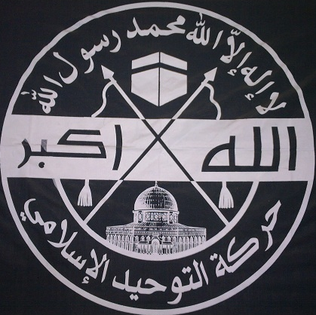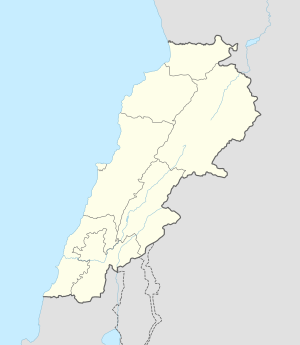
1991 (MCMXCI) was a common year starting on Tuesday of the Gregorian calendar, the 1991st year of the Common Era (CE) and Anno Domini (AD) designations, the 991st year of the 2nd millennium, the 91st year of the 20th century, and the 2nd year of the 1990s decade.

The 1982 Lebanon War began on 6 June 1982, when Israel invaded southern Lebanon. The invasion followed a series of attacks and counter-attacks between the Palestine Liberation Organization (PLO) operating in southern Lebanon and the Israeli military that had caused civilian casualties on both sides of the border. The military operation was launched after gunmen from the Abu Nidal Organization attempted to assassinate Shlomo Argov, Israel's ambassador to the United Kingdom. Israeli Prime Minister Menachem Begin blamed Abu Nidal's enemy, the PLO, for the incident, and used the incident as a casus belli for the invasion.

Camille Nimr Chamoun OM, ONC was a Lebanese politician who served as President of Lebanon from 1952 to 1958. He was one of the country's main Christian leaders during most of the Lebanese Civil War (1975–1990).

The Lebanese Civil War was a multifaceted armed conflict that took place from 1975 to 1990. It resulted in an estimated 150,000 fatalities and also led to the exodus of almost one million people from Lebanon.

Charles Helou was a Lebanese politician and President of Lebanon from 1964 to 1970.

The Amal Movement is a Lebanese political party and former militia affiliated with the Shia community of Lebanon. It was founded by Musa al-Sadr, Mostafa Chamran and Hussein el-Husseini in 1974 as the "Movement of the Deprived." The party has been led by Nabih Berri since 1980. The Greek Catholic Archbishop of Beirut, Grégoire Haddad, was among the founders of the movement.
The War of the Camps, was a subconflict within the 1984–1990 phase of the Lebanese Civil War, in which the Palestinian refugee camps in Beirut were besieged by the Shia Amal militia.

The Lebanese Forces is a Lebanese Christian-based political party and former militia during the Lebanese Civil War. It currently holds 19 of the 128 seats in Lebanon's parliament and is therefore the largest party in parliament.
The War of Liberation was a sub-conflict within the final phase of the Lebanese Civil War between 1989 and 1990, in which the Lebanese Army loyal to General and Prime Minister Michel Aoun, appointed by previous President Amine Gemayel and headquartered in eastern Beirut, fought against the western Beirut-based Syrian Armed Forces and the Lebanese Army loyal to President Elias Hrawi and Prime Minister Selim Hoss, appointed by the Taif Agreement. Aoun launched several offensives against the Lebanese Forces in an attempt to establish his authority over East Beirut. The conflict culminated on 13 October 1990, when the Syrian Army stormed Baabda Palace and other strongholds of Aoun, killing hundreds of Lebanese soldiers and civilians and ousting Aoun, marking the end of the Lebanese Civil War. Aoun survived and moved to France to live in exile.

The South Lebanon conflict, designated by Israel as the Security Zone in Lebanon Campaign, was a protracted armed conflict that took place in southern Lebanon from 1985 to 2000. It saw fighting between Israel and the Catholic Christian-dominated South Lebanon Army (SLA) against Hezbollah-led Shia Muslim and left-wing guerrillas within the Israeli-occupied "Security Zone"; the SLA had military and logistical support from the Israel Defense Forces over the course of the conflict and operated under the jurisdiction of the Israeli-backed South Lebanon provisional administration, which succeeded the earlier Israeli-backed State of Free Lebanon. It can also refer to the continuation of the earlier conflict in this region involving the growing Palestinian insurgency in South Lebanon against Israel following the expulsion of the Palestine Liberation Organization (PLO) from Jordan after Black September. Historical tensions between Palestinian refugees and Lebanese factions contributed another layer to the Lebanese Civil War (1975–1990), which saw the Maronite-led Lebanese Front and the Shia Amal Movement at war with the PLO. Hence, the South Lebanon conflict can partly be seen as an extension of the civil war that ended in 1990.
The Lebanon hostage crisis was the kidnapping in Lebanon of 104 foreign hostages between 1982 and 1992, when the Lebanese Civil War was at its height. The hostages were mostly Americans and Western Europeans, but 21 national origins were represented. At least eight hostages died in captivity; some were murdered, while others died from lack of adequate medical attention to illnesses. During the fifteen years of the Lebanese civil war an estimated 17,000 people disappeared after being abducted.

The Islamic Unification Movement – IUM, also named Islamic Unity Movement, but best known as Al-Tawhid, At-Tawhid, or Tawheed, is a Lebanese Sunni Muslim political party. It plays an active role in Lebanese internal politics since the Lebanese Civil War in the 1980s.
Ansar is a village in the Nabatieh Governorate region of southern Lebanon located between Nabatieh and Tyre, Lebanon, next to the village of Doueir. It has a population of 31,970.

The Lebanese Resistance Regiments (Arabic: أفواج المقاومة اللبنانية, romanized: ʾAfwāj al-Muqāwama al-Lubnāniyya, or أَمَل AMAL), also designated Lebanese Resistance Battalions, Lebanese Resistance Detachments, Lebanese Resistance Legions and Battalions de la Resistance Libanaise (BRL), but simply known by its Arabic acronym أَمَل ʾAmal which means "Hope", were the military wing of the Amal Movement, a political organization representing the Muslim Shia community of Lebanon. The movement's political wing was officially founded in February 1973 from a previous organization bearing the same name and its military wing was formed in January 1975. The Amal militia was a major player in the Lebanese Civil War from 1975 to 1991. The militia has now been disarmed, though the movement itself, now known as the Amal Movement (Arabic: Harakat Amal), is a notable Shia political party in Lebanon.

During the 1982 Lebanon War, the city of Beirut was besieged by Israel following the breakdown of the ceasefire that had been imposed by the United Nations amidst the Lebanese Civil War. Beginning in mid-June, the two-month-long siege resulted in the expulsion of the Palestinian Liberation Organization (PLO) from Beirut and the rest of Lebanon.

The Maarakeh bombing took place on 4 March 1985, a bomb exploded in a Shiite religious center (Hussainiya) in the southern Lebanese village of Maarakeh. 15 people were killed, including two leaders of the Amal movement that was fighting Israel, and 55 were injured. Author Nicholas Blanford said that the bomb was "planted by the Israelis during the earlier raid" [on 2 March] while according to Robert Fisk, French intelligence in Lebanon believed that Israel planted the bomb. Israel denied involvement. In 2018, Ronen Bergman wrote in Rise and Kill First, that it was Mossad agents commanded by Meir Dagan who planted the bomb.
The 1984 Sohmor massacre, also known as the first Sohmor massacre, took place on 20 September 1984 when the South Lebanon Army, backed by the Israel Defence Forces, fired guns and killed 13 civilians in the Lebanese village of Sohmor.

Sidon is one of the oldest inhabited cities in the world and has a rich and diverse history that spans over 6,000 years. The city's name has changed over time and has been known by various names, including Sidun, Saida, and Saïd. The earliest evidence of human settlement in the area dates back to the Neolithic period, around 4000 BCE. Sidon rose to prominence during the Bronze Age and became one of the most important city-states in the region. It was a major center for trade and commerce and played a significant role in the Mediterranean trade network. The city's strategic coastal location made it a hub for maritime activities.
The National Salvation Front was a Lebanese political alliance which was founded during the Lebanese civil war in opposition to Amine Gemayel's government and the agreed conditions of Israeli troop's withdrawal in 1983. It was considered the parliamentary wing of the Lebanese National Resistance Front militia.













